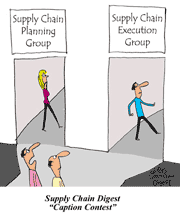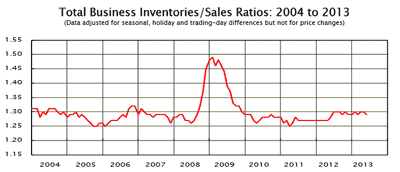 |
July 26, 2013 - Supply Chain Newsletter |
 |
| FEATURED SPONSOR: KEWILL |
 |
Logistics in 2020: The Future is Closer Than You Think |
 |
|
||||||||||||||||||||||||||||||||||||||||||||||||||||||||||||
Inventory Performance 2013For the last several years, I have been doing reporting and analysis on company and sector inventory levels based on the annual Working Capital scorecard that is compiled by REL, a division of the The Hackett Group. It is always one of our most popular columns of the year.
Once again this year, REL has been kind enough to send me the data set for some further analysis. The just released 2013 data is based on year-end 2012 financials from 1000 US public companies. The full report and data set looks at the full spectrum of working capital: Days Sales Outstanding (DSO), Days Inventory Outstanding (DIO), and Days Payables Outstanding (DPO). Here, we are going to focus on just the inventory component. DIO means how many days of sales a company is holding in inventory, and which REL defines as:
I want to make clear this is the definition REL uses in its data set. Every year, someone writes in telling me why I am wrong here, and my response is that this is the way REL calculates DIO, so that is what I must therefore use (and I think it is fine anyway). As such, DIO is sort of the reverse of inventory turns, in that a higher DIO, all things being equal, means poorer inventory management performance, while a lower number signals improvement. You are being more efficient with inventory versus a given level of sales. So, let's take an example. Building products company Owens-Corning had about $5.1 billion billion in sales in 2012. Divided by 365 days in a year, that means the company sold about $14.1million worth of insulation and other stuff per day. It also ended the year with $786 million in inventory. So dividing that inventory number by the $14.1 million in sales per day means Owens-Corning held on average inventory equal to about 55.4 days of its sales. Office furniture maker Herman Miller, by contrast, manages to hold just about 15 sales day's worth of inventory. Best Buy held 41 days worth. In case you were curious, Owens-Corning's 55.4 days of DIO could be compared to its inventory turns level of 5.5 days (Cost of Goods Sold divided by inventory levels). But you can by no means say every company with DIO of 55.4 has inventory turn of 5.5. The margins/cost of goods sold vary by company, making that linkage impossible. In the overall US economy, inventory levels have remain relatively flat since about 2005, when compared to sales. As seen in the chart below, the "inventory to sales" ratio did spike in late 2008/early 2009 as the recession caught companies with way more inventory than needed versus suddenly shrinking demand, but they then chopped away at that inventory ruthlessly, so that it was back on the longer term trend line by early 2010. However, according to this government data, inventory levels, especially among retailers, popped up a bit in the second half of 2012 as shown below.
The leaves the overall inventory to sales ratio is now up a bit from recent lows in early 2011. Now, back to the REL data. It is great, but the biggest value-add SCDigest performs here is to re-sort individual companies into new categories, so the categories and comparisons in our view are more usable for supply chain thinking. For example, home builders like Toll Brothers were mixed in the household durables category with companies like Whirlpool. That may have been the most "apples and oranges" combination, but there were a number of others that didn't quite jive, at least from a supply chain perspective. Metal producers such as US Steel were in the same category as miners. So, we do the hard work of first eliminating sectors that aren't useful for the supply chain (e.g., bankers, etc.), and then redefining and populating the categories in a way that makes more sense for the supply chain. As another example, rather than having one giant category of all specialty retail, we broke that down into apparel, office products, etc. It really does take a lot of time.
In the end, we simply made choices, including looking up more details on a number of companies with which we were not familiar, and in some cases looking up the data ourselves for a handful of notable companies that were missing for some reason. So all that doesn't leave me much room here. You will find a complete table of the almost 60 categories we used here, ranked from lowest DIO to highest, and the change from 2011 to 2012: DIO By Sector 2012. Note: you may have to "zoom in" in your browser to see it well. Top 5 lowest DIO: (1) Restaurants: 8; (2) Airlines:8; (3) Retail Convenience Stores: 9; (4) Retail Wireless Systems: 13; (5) Toys: 14 Top 5 highest: (1) Spirits:190; (2) Retail Auto Parts: 110; (3) Retail: Other Specialty - 89; (4) Construction Equipment: 82; (5) Aerospace/Defense Components: 72. Three best performing sectors (biggest drop in DIO from 2011 to 2012: (1) Construction Equipment: -11.9%; (2) Food Manufacturing: -10.7%; (3) Contract Manufacturers: -7.8%. Three worst performing sectors (largest rise in DIO): (1) Spirits: 10.7%; (2) Electric Utilities: 9.9%; (3) Retail Wireless Services: 9.9%. In our On-Target newsletter next week, we will provide even more detail on this data, also look at which individual companies made big progress, such as sports apparel maker Under Armour, which managed to drop DIO from 80 to 64 days last year, an improvement of 21%. Nice job. We'll also detail which companies are in which sectors. Look for that next week. Finally, I took a look at three specific sectors, using the same exact companies, for select years from 2004 through 2012.
Is that inventory progress or not? Will also do this analysis for additional sectors next week. Any reaction to this year's inventory numbers? What other analysis would you like to see? Let us know your thoughts at the Feedback section below.
|
|||||||||||||||||||||||||||||||||||||||||||||||||||||||||||||
|
|||||||||||||||||||||||||||||||||||||||||||||||||||||||||||||
|
|
|
YOUR FEEDBACK
Will publish a few good emails we've received lately, including a great when from David Schneider, who was at the State of Logistics press conference in Washington DC in June, and adds some nice comments from the panel discussion that augment our coverage of the written report.
And that makes it our Feedback of the Week! Plus interesting letters on the whole apparel supply chain troubles discussed above.
Feedback of the Week - On the State of Logistics Press Conference
I was present at the press conference, front row, and took notes of the Q&A session after. The opening question focused on the significant challenges each of the panel saw in 2012, and was the outlook optimistic or pessimistic: Marc Althen (president of Penske Logistics) said Penske saw an upturn as more shippers looked for 3PL services to help adjust for greater complexity in the networks: he is optimistic. Brent Beabout (Senior Vice President, Supply Chain for Office Depot ) said that the B to B business is not recovering quickly, and they continue to see pressure to improve operations by serving omni-channel demand through the same network. Cautious optimism. Steven Bobb (exec VP at BNSF) said BNSF structural changes in demand volume shifted from coal and grain to intermodal, oil and oil related industrial movements. Cautious optimism. Beth Ford (chief supply chain officer at Land O'Lakes) reported that her company saw robust growth in food commodity movements, more on a global scale. She is optimistic. Paul Svindlands (COO of Pacer) said that Pacer is cautious about its optimism, that while there will be growth, it will not be exciting growth. Paul is new at Pacer - and did not really comment about 2012. The most interesting questions and answers: HOS Impacts: Paul - Dray carriers will not be impacted anywhere like regional and long haul carriers. What kills the dray carriers productivity is the time at the ocean terminals. Rail ramps are efficient and drivers do not see the 2 - 3 hours delays that drivers see in LA or Newark. Marc - Penske expects a 3% hit to productivity. Driver Shortage: The panel all comments. Roz pointed out that the opportunity to pick up the young drivers is when they get out of High School, but they can't get a CDL until they are 21. By that time the kids are already down a different path and not likely to change careers. Beth - the Daughter of a Truck Driver - said that the changes in the industry, and the options, makes driving less attractive. Biggest concern for 2013: Marc - Human Capital. Beth chimed in on this later, and it worked in with more driver shortage comments. Beth spoke about "The War for Talent" where she goes to colleges and finds it difficult to get the business school students excited about supply chain and logistics. She talked about a need to "change the dynamic of how people look at the career, and the impact logistics has on many parts of the organization." She went on to talk about finding people that could communicate and collaborate, not only internally, but to help "educate the front of the house to understand what the back of the house does." On the Human Capital issue, Steve had one of the best quotes: "For our front line supervision, as a railroad we are an outdoor sport. So we turn to the military to look for the front line leaders we need to put in the field." On the question about conversion from road to rail, the specific question asked about the length of haul where it makes sense to convert. Steve commented that it is more of a structural issue, that BNSF network is a long haul railroad, so by design the distances are longer than in the East. "We have ample opportunities with the structure we have, so we will focus to increase our take of what our current network supports." David K. Schneider
|
||
| Feedback on the Whole Apparel Supply Chain Saga | ||
You raise a very interesting question regarding inflections points. I think the major change is the depth of involvement that Wal Mart appears to be taking. I just wonder how much cost can be absorbed before it finds its way into the consumer's cost. I also think that many consumers might be ok with paying more to avoid future tragedies even in countries far removed from the U.S. |
||
| Feedback on What Took the Apparel Industry So Long to Address Issues? | ||
Your answer is obvious; there is no ROI in responsible sourcing. All of the incentives promote willful ignorance in the service of increasing profits and market share. I was at a food conference recently where one of the keynote themes was "Food safety should not be a competitive advantage," highlighting companies (like Earthbound and others) that share their research and innovations with the industry. One speaker got up later and said, "That's true, unfortunately blindness and irresponsibility are an advantage, allowing companies to offer lower prices and gain market share." This is equally true in apparel, consumer electronics and other industries where price is everything. Until you see CEO's comp plans with significant bonus for "0 worker injuries at supply chain partner sites" and similar measures, nothing will get fixed. Bill Alrich |
||
As one of those "human and workers' rights types," I'd like to welcome you to the party. I have been working on the Nike sweatshop issue in Indonesia for 15 years now and I can tell you that nothing of significance has changed, regardless of what Nike tells you in their CSR report. I hope you will keep pushing on this issue.
|
SUPPLY CHAIN TRIVIA ANSWER
Q: What happened between Walmart and Procter & Gamble in 1998?
A: Started the game-changing "continuous replenishment" program – after Kmart famously passed on the idea.
| © SupplyChainDigest™ 2003-2013. All Rights Reserved. SupplyChainDigest PO Box 714 Springboro, Ohio 45066 |
POWERED BY: XDIMENSION
|







 It
is far from perfect. Should Johnson & Johnson be placed in the
pharma group, the medical device category, or consumer packaged goods,
as it does all of that? Is Honeywell in the aerospace or automotive
sector, or one of the few "industrial conglomerates" like GE or 3M?
That's where we put it this year.
It
is far from perfect. Should Johnson & Johnson be placed in the
pharma group, the medical device category, or consumer packaged goods,
as it does all of that? Is Honeywell in the aerospace or automotive
sector, or one of the few "industrial conglomerates" like GE or 3M?
That's where we put it this year.

